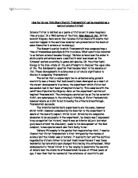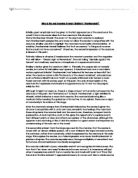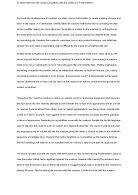Discuss the sources of discontentment and/or despair in 'Frankenstein' by Mary Shelley
'Then the discontented wanderer is thrown back on himself - if his life is to become bearable, only he can make it so. And, on that spring evening, walking up the long, dark, murmuring street toward the boulevard, Eric was in despair. He knew that he had to make a life, but he did not seem to have the tools' (Another Country, pp.213/4). Discuss the sources of discontentment AND/OR despair in Mary Shelley's 'Frankenstein' The depiction of despair, in varying forms, is perhaps predominantly engendered in its purest form within the individual character's guilt as a fundamental essence of their characterisation. In relation to Frankenstein, this inclination is explicit in Victor's tormenting guilt surrounding the murder of William, Justine and Clerval: 'But I, the true murderer, felt the never-dying worm alive in my bosom, which allowed no hope or consolation...Anguish and despair had penetrated into the core of my heart' (Shelley, p. 68). This 'never-dying worm' takes on symbolic significance in the creature, who acts as a physical representation of Victor's guilt synonymous with these murders, and is therefore a constant reminder of remorse, instigating the escalation of his profound despair. Furthermore, Victor's guilt, thus his despair, is subject to Freudian interpretation, particularly in his dream immediately following the creation of the monster: on envisaging
To what extent is ''Frankenstein' concerned with the theme of education and what does it have to say about the advantages and disadvantages of this?
To what extent is ''Frankenstein' concerned with the theme of education and what does it have to say about the advantages and disadvantages of this? In Frankenstein, education cannot simply be considered as an ordinary theme, because there are so many differing angles which are represented throughout. It primarily depends however on what actually counts as education in the first place; does it have to be necessarily formal, or does it also count if it is information passed on from one family member to another, or even if it is simply something gleaned from the environment that surrounds us. This is the question that must be answered, as well as deciphering what methods Shelley uses to convey the fact that education is essential for the books' events to occur. In Frankenstein from the very beginning, whenever Victor is mentioned, it is in the context of learning, or of having learnt something crucial. This is in comparison to Walton, whose knowledge appears to come from his exploration, from his search for a true companion who can accompany him throughout the rest of his life, someone who will truly understand him. Walton's knowledge is not just from experiences, but also from studying, from academia, as well as from his perceptions of the world around him, and from what his morals command him to either do or not to do. However, despite all of his academia, he is still
Frankenstein - the role of Safie in the novel.
Q.CRITICALLY ANALYSE THE ROLE OF SAFIE. "Whoever fights monsters should see to it that in the process he does not become a monster" -Friedrich Nietzsche Written in 1816, when the writer M.Shelley was just nineteen her novel "Frankenstein", a Sui Generis dramatized the potential of life begotten upon a laboratory table. M.Shelley merges many forms of writing- the memoir, the journal, the letter novel, the picaresque to produce themes as romantic myth making, the gothic project, contemprory history and politics and the discourse of gender. In the novel, one also witnesses two families working on opposite set of ideologies. On the one hand, where Frankenstein's family represents vision pattern of political inequality and injustice, the De Lacey family represents vision of a social group based on justice, equality and mutual affection. The structure of De lacey's family constitutes M.Shelley's ideal, an ideal derived from her mother's "A Vindication of the Rights of Woman". Infact, it is the character of Safie, the beloved of Felix De Lacey which best exemplifies to it which shall be discussed in the following paragraphs. Safie, the daughter of the Turkish merchant is appalled by her father's betrayal of Felix and by the Islamic oppression of women he endorses. Therefore, she decides to escape from the clutches of her father and flees from Turkey to Switzerland, seeking
How far do you think Mary Shelly.doc
How far do you think Mary Shelly's 'Frankenstein' can be regarded as a work of science fiction? Science Fiction is defined as a 'genre of fiction set in some imaginary time or place.' In a 1960 survey of the field, New Maps of Hell, British novelist Kingsley Amis wrote that 'science fiction deals with events that could not happen in the world we know but are presented on the basis of some innovation in science or technology'. The Romantic period in which 'Frankenstein' was composed was a time of tremendous paradigm shifts in science. What used to be referred to as 'natural science' became 'biology'. 'Natural science' was the order in which plants and animals were classified in what was known as the 'Linnaean' system according to genus and species. On the other hand, biology is the bios- study of life, and attempts to discover the logos-idea of life. The fundamental question then became 'what is the essence of life'. These developments in science was all of crucial significance to Shelley in composing 'Frankenstein'. The notion that a corpse might be re-animated using galvanic electricity was a theory that had recently been developed as a result of the recent developments in science, the experiment which Victor had succeeded, had in fact been attempted in reality. This complies with the conditions stipulated by Kingsley Amis, as the experiment carried out inspired
comparison, victor and monster
Compare the characters of the creature and Victor Frankenstein, and consider the importance of this comparison. In Mary Shelly's Frankenstein, she draws a flow of contrast within the characters of the creature and Victor Frankenstein. She manipulates the differences and similarities in an effective way. Most of these she presents through their words, expressions, thoughts and emotions throughout the novel. The first presentation of contrast between the two is that they are both 'alike', by mentioning this word, I do not refer to physical resemblance as one may think, infact I am looking at the characteristic likelihood of Victor and the creature. Victor creates the monster to be like himself, he did not however, plan his creation to become like him, but it did indeed. The monster does not resemble Victor physically however; instead they share the same personalities. For example, they are both loving beings, they both want to help others and want what is best for them, even though they do not manage to accomplish that. As the character of the creature, Shelly provides us with some information about the monster before it has even been created. Things such as that he is being created from parts taken from morgues and graves. We also know that his limbs have been stitched together as we also told that he is going to be eight feet tall. These facts show that his physical
Who is the real monster in Mary Shelleys Frankenstein
Who is the real monster in Mary Shelley's "Frankenstein" Initially, great emphasis must be given to the first appearance of the creature in the novel. It has to be made clear that the narrator in this chapter is Victor Frankenstein himself. The event of the creature's creation is explored from Frankenstein's perspective and does not allow the reader to empathise with the creature. Shelley uses this to highlight the monsters more horrific characteristics. In addition, Frankenstein himself believes that he has created "a thing such as even Dante could not have conceived". Therefore, the reader's impression of the creature is biased at this point. Pathetic fallacy in chapter 5 foreshadows the monster's creation and the tragedies that will follow - "Dreary night of November" .The rain falling "dismally against the frames" and darkness, creates an atmosphere of a supernatural nature. Shelley's diction gives the creature's birht a Primarily, the corpse did not sweetly awake, but when its 'dull yellow eye' opened, 'it breathed hard and a convulsive motion agitated its limbs'. Frankenstein had 'selected his features as beautiful', but when the creature came to life 'the beauty of the dream vanished', as luxuriances such as 'lustrous black' hair and 'teeth of a pearly whiteness' only formed a more 'horrid contrast with his watery eyes'. At this point, the only characteristic of the
''mistakes in frankenstein''
'How and what causes characters to learn from their mistakes' In Frankenstein, listening is an important theme in the characters learning from their past mistakes. The novel is written in a narrative form, which allows the story to be relayed through other characters several times. The reader and Mrs. Saville are the first people who listen to Frankenstein's story through Walton's letters home. Walton listens to Frankenstein's story from Victor, and Frankenstein listens to the monster's story. Each person's story has a message or warning that they need to relay to the other and upon hearing their story they each learn of their past mistakes and how to correct them. Mary Shelly emphasizes the importance of listening through a series of key characters. Mrs. Saville and the rest of society read Walton's letters which tell Victor Frankenstein's story. This is the outermost layer of the narrative format of the novel. Mrs. Saville is Walton's sister; he begins writing her letters on his mission to the Artic to let her know that he is in good health. When he comes across Victor Frankenstein he records Frankenstein's story in his letters home to Margret. Victor's story is supposed to communicate a warning to society. The warning is to not become so wrapped up in the pursuit of knowledge that contact with other people becomes unimportant. Isolating oneself from society due to
Many critics have commented that the creature is ultimately a character with whom we can sympathise. Explore Shelleys presentation of the creature in the light of this view.
Many critics have commented that the creature is ultimately a character with whom we can sympathise. Explore Shelley’s presentation of the creature in the light of this view. The way Mary Shelley presents Frankenstein’s monster challenges society and their views on morality. Her aim seems to be to make the creature seem as human as possible and lack in the things that humans would take for granted. For example, something as simple as a name, giving an identity, something the reader takes for granted but the monster so desperately wishes to have. The first time we hear the monster speak articulately is when I think the reader’s sympathy begins to be provoked. We have previously only heard of his hideous form from Frankenstein, his prime enemy. Frankenstein’s instant dislike to the creature once his creation is finished, is a shock to the reader as he previously describe it as ‘Beautiful!’ with such enthusiasm and excitement. His hatred for the monster could easily sway the reader to feel the same way as we have gained trust in Victor’s narration. Despite this we have not yet heard the creature’s voice and are simply making a judgement on his appearance. This presents the question of who really is the monster. Human nature for being so judgemental and corrupt, or the creature because of his huge form and frustration. In the first Volume Mary Shelley then
To what extent can the reader sympathise with the creature in Frankenstein?
To what extent can the reader sympathise with the creature in Frankenstein? The cruel and heartlessness of monsters are often used in Gothic fiction to create a feeling of horror and terror in the reader. In Frankenstein, Shelley takes the creature further than this by providing him with human qualities making him more abhuman. Sympathy is created for the creature by centring him as the victim of the novel as he is rejected by his creator and society making him relatable to the reader and provoking pity. However the creature’s monstrous turn in using violent behaviour, and initial bias already set up by Victor’s descriptions make it difficult for the reader to sympathise with him. Shelley directs sympathy to the creature by placing him as the victim of the novel. Victor takes on the role of a typical Gothic monstrous mother by rejecting his creature at ‘birth’. Upon seeing his creature Victor sees it as a ‘catastrophe’ to have ‘miserably given life’ and instantly flees. Shelley emphasises the feeling of rejection the creature felt by his intertextual reference to Adam in Paradise Lost, saying ‘I remembered Adam’s supplication to his Creator. But where was mine?’, it demonstrates to the reader how the abandonment of Victor has not only hurt the creature but left him confused which provokes the readers sympathies. Throughout the novel the creature is
To what extent is Frankenstein a criticism of societys attitude to accommodate what it sees as monsters, aliens and exiles?
To what extent is ‘Frankenstein’ a criticism of society’s attitude to accommodate what it sees as monsters, aliens and exiles? ‘Frankenstein’ was written in an era when gothic horror was widely read and very popular, especially with women. Discussing gothic horror was a common past time amongst women and it was acceptable for more unorthodox views to be expressed. Writers knew that mystery and horror were important elements that made up gothic horror which would almost certainly have influenced Shelley’s writing. ‘Frankenstein’ contains many characters which could be seen as monsters, aliens and exiles and Shelley is very particular in the way in which they are portrayed and accepted by society. It appears that in ‘Frankenstein’ society is itself what creates the monsters – after all, the monster only becomes monstrous after being exiled and mistreated by society. This begs the question – is Victor a metaphor for society and how twisted it has become? Shelley ensures that the audience feels pity for the exiles as they are mistreated. The monster is perhaps the most obvious ‘exile’ and is mistreated in many instances. Firstly by his creator – Frankenstein – which means, in his childlike state, he has no guidance in the world. The first time the monster encounters humans is a jarring way to be introduced to the world of men ‘some attacked me,











